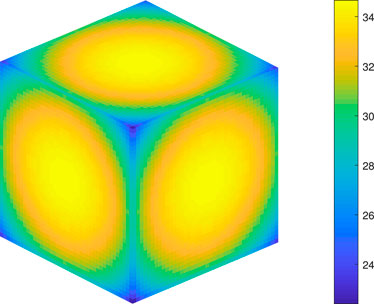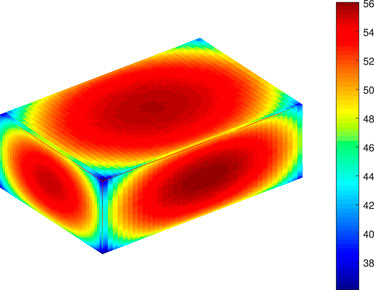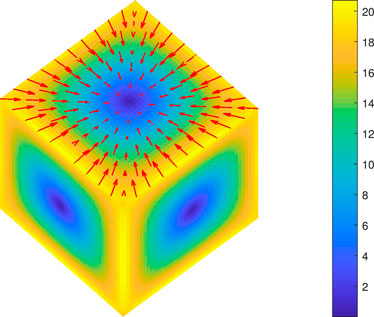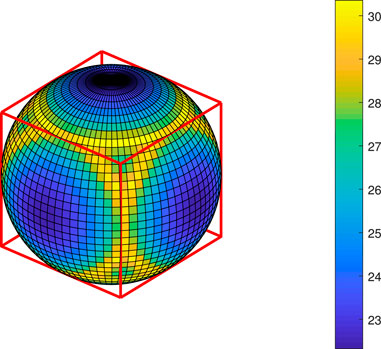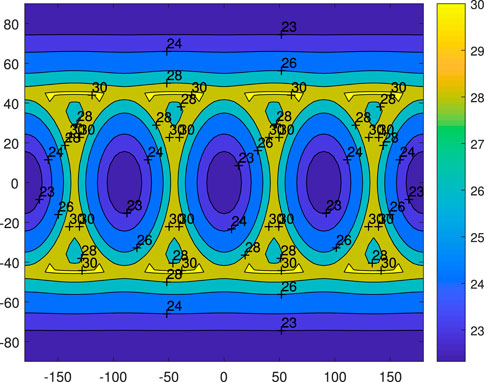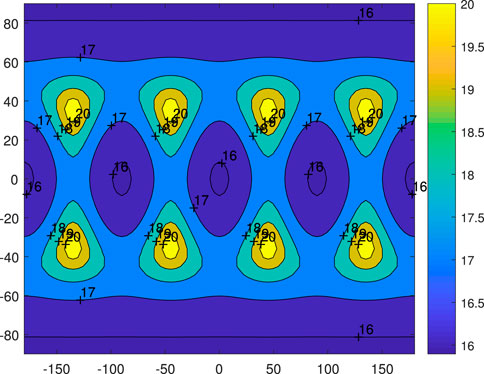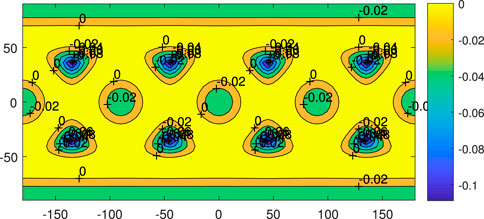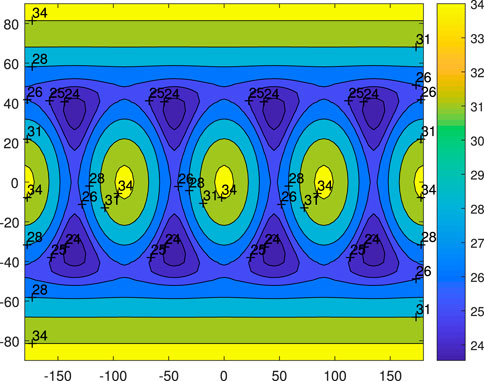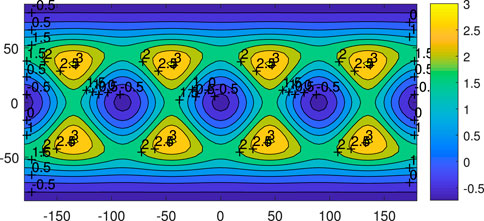- School of Astranautics, Beihang University, Beijing, China
For convenient comparison and clear physical meaning, the gravity on the surface of a homogeneous cube and on spheres inside, outside, and intersecting about it is calculated by polyhedral or harmonic expansion methods. In addition, the gravity coefficients of a rectangle’s spherical harmonics are both derived analytically and evaluated numerically, where only five terms are nontrivial up to the order of 4, which is somewhat unexpected when we first obtained them. There are some similarities of these coefficients to an ellipsoid for the terms
1 Introduction
A cube’s or a rectangle’s gravity is of interest to researchers in areas including the theoretical analysis in the history of gravity research (MacMillan, 1958; Waldvogel, 1976; Nagy, 1966; Banerjee and Buddhadeb, 1977; Michalodimitrakis and Bozis, 1985), mission design around irregular bodies (Werner, 1994; Hu and Scheeres, 2002; Chappel and Abbott, 2012), and the application of satellite gravity to mission design or gradiometry (Venditti and Prado, 2019; Liu et al., 2011; Parikh and Tewari, 2021). Much of this research addresses the potential and gravity of rectangles, but little of it discusses the gravity on surface of a rectangle, and very little calculates the gravity inside a rectangle.
Modeling the gravity near a celestial body is an important issue for spacecraft landing, taking off, and flying around it (Scheeres et al., 1996; Hu and Scheeres, 2004; Hu and Scheeres, 2014; Herrera et al., 2013; Hu, 2015), especially for irregular bodies (Mysen et al., 2006; Fukushima, 2017; Pinson and Lu, 2019; Nikolaeva et al., 2019; Valvano et al., 2022). The key issue in all this research is modeling the gravity around irregular asteroids. While many methods have been studied, the most efficient approaches are harmonic expansion and polyhedral models, which are respectively fast and precise in computation.
Just like an ellipsoid (Guibout and Scheeres, 2003; Dobrovolskis, 2019), a rectangle is also a basic element in the structure of gravity research. A really complicated shape can be composed of these elements, such as ellipsoids and rectangles. A cube could be used to simulate some special asteroids whose shape is similar to a cube, or a part of irregularly shaped asteroids. For example, the shape of asteroid 4,769 Casterlia (Hudson and Ostro, 1994) is similar to a rectangle, or, more accurately, it can be regarded as two connected cubes with smooth corners. Extended discussion about this asteroid is given at the end of this paper. The most important characteristic of a cube’s gravity is that its physical meaning and pattern are clear, such as the gravity distribution on its surface, which is helpful for understanding the nature of near-central body gravity, including for asteroids. Another example is the recently discovered mystery object with many uncertainties, 1I/2017U1(Oumuamua) (Bannister et al., 2019), which recently passed through our solar system. It is remarkable not only because of its unique orbital eccentricity of about 1.2 and its probably being an interstellar asteroid, but also due to its very elongated shape with sharp edges and near planar surface. Its extreme axis ratio is at least 6:1, and even probably up to 10:1 (
Many have studied the gravity fields of asteroids as an example of irregularly shaped bodies. Werner and Scheeres (1997) proposed the application of polyhedral methods to evaluate the exterior gravitational field on irregularly shaped asteroids; they calculated and compared acceleration magnitudes mainly on different special planes such as
This study discusses the parallel gravity of an ellipsoid or an asteroid to rectangles with the same objectives to reveal some aspects of the basic nature in gravities of different shapes by different methods, with some special analytical conclusions. The remainder of this article is organized as follows. Section 2 briefly introduces the definitions of harmonic expansion and the polyhedral method, including the coordinate transformation of derivatives. In Section 3, the 3D and 2D gravity distributions of cubes are plotted, then the harmonic expansion coefficients up to the sixth degree and order are calculated. For comparative convenience, a rectangle’s surface gravity and harmonic coefficients are assessed, including their analytical formulation. Many examples of gravity accelerations both on surfaces on and spheres around a cube are then calculated, including motion examples and analysis, and many comparisons given. Finally, Section 5 provides conclusions, explanations, and also some extensions to an asteroid and an ellipsoid.
2 Gravity calculation method
2.1 Spherical harmonic expansion
The spherical harmonic gravity field is widely adopted with coefficients associated with Legendre functions of degree
where
where
Spherical harmonic expansion can only be used to calculate gravity potential directly outside a celestial body, but it is not suited to evaluating gravity on the surface and inside, or even near but outside, a celestial body. Examples are given below. See Figure 1 as an example, which shows the gravity potential on a sphere outside a cube. Note that the potential unit in this paper can be normalized as any value. Here we pay more attention to the relative value—the patterns of the gravity.
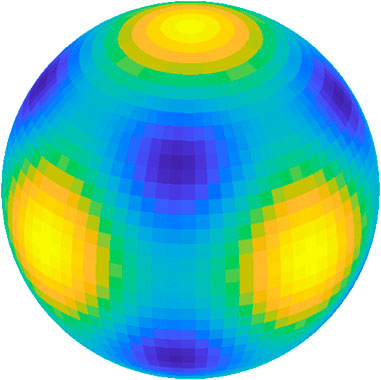
Figure 1. Gravitational potential on a sphere outside a cube. Note that the potential unit in this paper can be normalized as any value by Eq. 4.
2.2 Polyhedral method
For a polyhedral gravity field, the potential of a spacecraft at position r is (Werner and Scheeres, 1997):
where density
as the spacecraft’s gravitational acceleration is generally no longer on the radius directions for a non-spherical central body. In these calculations, some transformations are needed from spherical coordinates to Cartesian coordinates:
The polyhedral method can calculate gravity outside a celestial body, and it can also be used to calculate gravity near the surface on a celestial body; however, here we try to apply it to calculate the gravity on and inside the surface of a celestial body without much modification of its algorithm. This is one of the major contributions of this paper. Many examples and analysis will be given below.
3 Gravity field calculations around a cube or a rectangle
Unlike most existing literature, which gives gravitational comparisons between polyhedral and harmonic expansion methods by calculating the gravity on a cross-sectional plane, such as
For a homogenous cube whose dimension is
Note that the acceleration unit in this paper can be normalized as any value. For example, if the length unit is kilometers, the density is about 1g/
3.1 The spherical harmonic coefficients around a rectangle
Due to the symmetry in a rectangle’s shape, the gravitational coefficients of its spherical harmonic expansion taken about its center of mass have a relatively simple form. First of all,
We can find that there is a similarity of the gravitational coefficients between a rectangle and an ellipsoid (Balmino, 1994; Scheeres, 2012), especially about
One simple way to calculate the spherical harmonic coefficients is to evaluate the gravity potential by Eq. 1 on a sphere outside the irregular central body using the polyhedral method. Then, by a usual least square algorithm, the coefficients can be obtained. See the compact form of the linear Eq. 12 about the coefficients. Since the
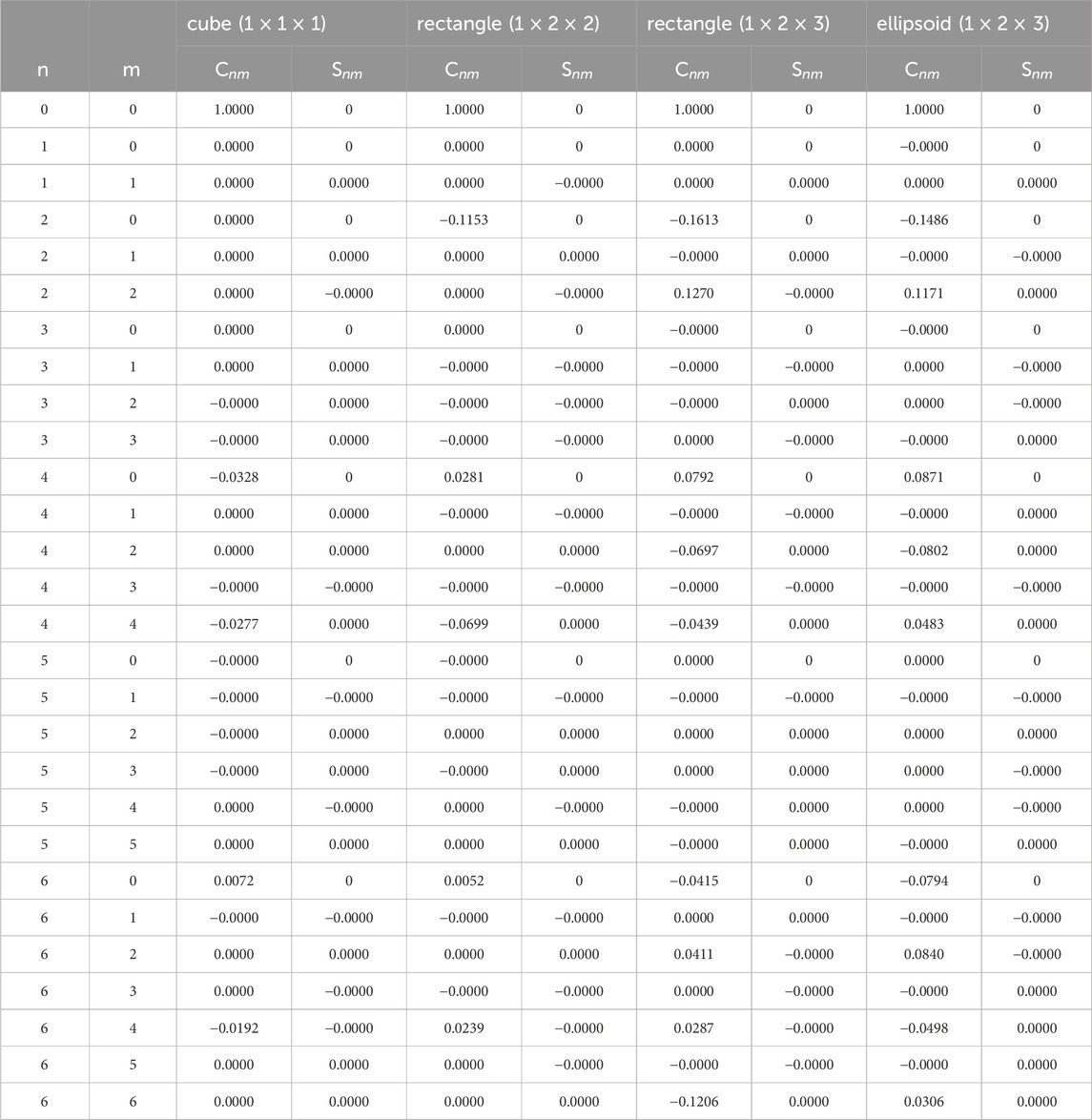
Table 1. Calculated normalized spherical harmonic gravity coefficients of a cube and rectangles to the order
The normalized spherical harmonic coefficient
3.2 Gravity on the surface of a cube and a rectangle
Figures 2 and 3 visualize the total polyhedral gravity magnitudes on the surfaces of a cube and a rectangle. In Figure 3, one unexpected result is that the maximum gravity appears at a center of the mid-planes with the dimension
3.3 Gravity on an intersecting sphere around the cube
Attention can be given to the special sphere with the radius
3.4 Gravity on a sphere outside the cube
For this, see Figures 7–9. For even larger spheres outside the cube, their overall gravitational patterns are all similar. Interested readers can compare Figure 7 to Figure 1, in that the place (above corner of the cube) on the sphere of larger gravity corresponds to the place with smaller potential, whereas the place (above the center of a plane) of smaller gravity corresponds to the place with larger potential on the sphere. Thus, the place on the sphere with larger potential is at the same place with smaller gravity, and vice versa is compatible with the general definitions of potential and gravity. Particularly in Figure 9, the overall error is acceptable, and largest errors appear near the corner of the cube at about 10%. The error in the large yellow part is very small. The accuracies can be improved even further by adding more spherical harmonic terms in the model, such as
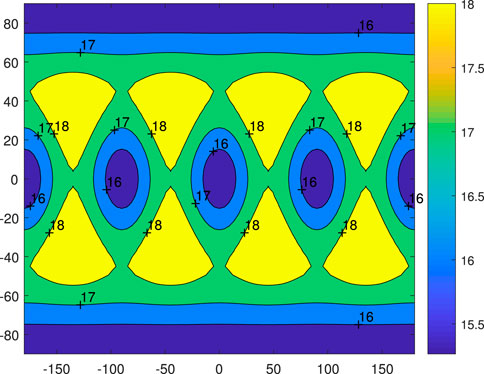
Figure 8. Gravitational field of 4th degree and order spherical harmonic expansion for cube on a sphere of radius 175, which is just outside the cube.
3.5 Gravity inside the cube
The polyhedral method is again applied to investigate the gravity inside a celestial body, which is closely related to the internal stress and strain. This kind of research is helpful for analyzing the internal structure and evolution of an asteroid. The gravity on a sphere
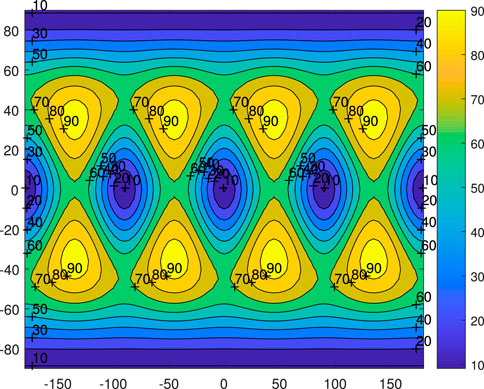
Figure 11. Gravitational field of 4th degree and order spherical harmonic expansion on sphere with radius 100 which is just completely inside the cube.
4 Application examples
4.1 Near circular orbit
With the polyhedral model, spacecraft landing and ascending trajectories can be calculated, but more interesting theoretical results can be obtained if secular motion is studied. The secular motion of periapsis in the orbital tori is similar to the well-known Mercury apsidal secular perturbation motion around the Sun. See Figures 13 and 14 and consider an initial circular orbit
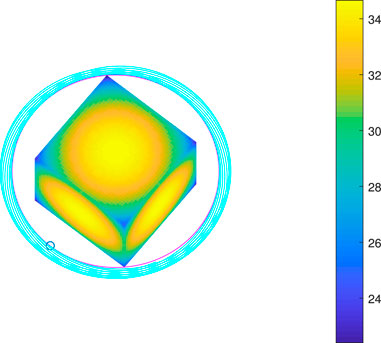
Figure 13. Example orbit around a cube with initial orbit in equatorial plane, calculated by polyhedral model.
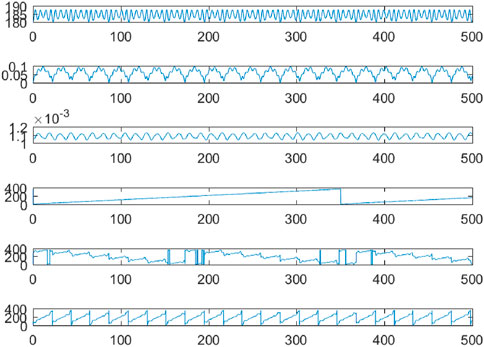
Figure 14. From top to bottom, calculated classical six elements for the orbit in Figure 13:
Short period oscillation is mainly due to the term
4.2 Motion on a surface
Figure 15 shows three examples of motion: a particle moving without friction in a straight line (green), a circle (red), and a general tori trajectory (blue) on a surface of a cube via polyhedral gravity calculations. When there is no initial lateral velocity, the dust or a cart’s motion is on a straight line (green line), like a spring’s harmonic motion. With the proper choice of lateral velocity, the motion can be in a periodic trajectory, similar to a circle (red circle). A random velocity normally leads to a tori trajectory (blue trajectory). The only forces acting on the particle are the gravity from the cube and the supporting force out of the surface. No friction is assumed here.
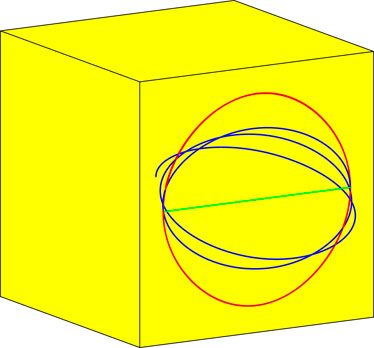
Figure 15. Particle on surface moving without friction in a straight line (green), a circle (red), a general tori trajectory (blue).
For a cube with dimension
Where the length of the cube is 2,
When friction exists, the tori and circle motion become spiral. The linear oscillation’s amplitude will dwindle. Finally, all the motions will be stopped at the center of the plane. This could be an explanation of why in the natural world a pure cube celestial body with sharp corners is rare.
5 Discussion and Conclusion
There is already some literature discussing the gravity of Asteroid 4,769 Castalia, original data of which can be found in Hudson and Ostro (1994). Here we show a different figure (Figure 16) which calculates and visualizes the surface gravity without centrifugal force resulting from rotation for theoretical comparison. More practical calculations about this irregularly shaped asteroid’s surface gravity, internal gravity, and slope with rotation can be found in our newly published paper (Hu et al., 2024). To theoretically understand the nature of gravity of different shapes by different methods, gravitational calculations are performed for a cube, but on its surface and different spheres around it by polyhedron and harmonic expansion methods for different cases. In these examples, a few different perspectives of these methods and results are revealed, such as the maximum gravity being at the plane’s centers and the minimum at the corners on the surface. For a sphere that intersects the cube, the maximum gravity is on the intersection between the cube and the sphere. This means that on the sphere, the gravities inside and outside the cube are smaller than the gravity on the intersection—that on the surface of the cube. If high-order coefficients of harmonic expansion are calculated for a cube, nontrivial terms are such as
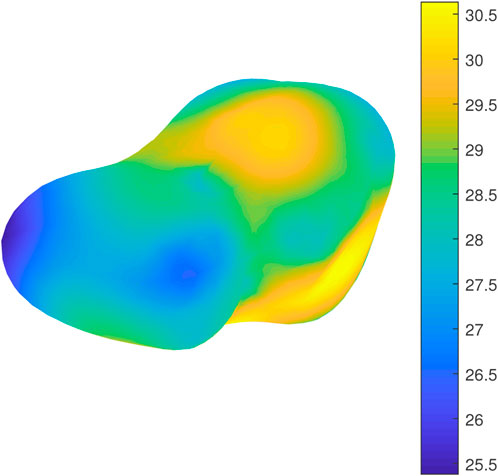
Figure 16. Gravitational acceleration on surface of asteroid 4,769 Castalia without rotation, unit:
It can be seen in Figure 16 that the asteroid can be approximated to two connected cubes with smooth corners. The local maximum surface gravity appears near the centers of the planes, and local minimum gravity is at the corners of the cube, which is compatible with the analysis of a rectangle’s gravity here.
Hence, in this study a cube’s gravity is focused, as its gravity acceleration distribution is regular, simple, and fundamental. These results could be interesting for readers in widely different research areas, just like an ellipsoid’s gravity which is also convenient for comparison—see the effective surface gravity slope in Figure 17, which differs from Figure 10 in Dobrovolskis (2019). In this paper,
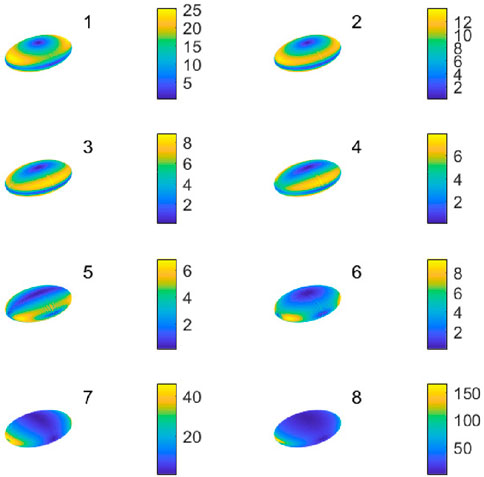
Figure 17. Effective gravity slope (deg) on rotating ellipsoid with angular velocity increasing from left to right and then from top to bottom, as the sequence subplot 1-8.
Data availability statement
The original contributions presented in the study are included in the article/Supplementary Material; further inquiries can be directed to the corresponding author.
Author contributions
WH: Funding acquisition, Investigation, Methodology, Writing–original draft. TF: Validation, Writing–review and editing. YW: Funding acquisition, Validation, Writing–review and editing.
Funding
The authors declare that financial support was received for the research, authorship, and/or publication of this article. This work was supported by the National Natural Science Foundation of China under Grant 11872007 and the Fundamental Research Funds for the Central Universities.
Conflict of interest
The authors declare that the research was conducted in the absence of any commercial or financial relationships that could be construed as a potential conflict of interest.
Publisher’s note
All claims expressed in this article are solely those of the authors and do not necessarily represent those of their affiliated organizations, or those of the publisher, the editors and the reviewers. Any product that may be evaluated in this article, or claim that may be made by its manufacturer, is not guaranteed or endorsed by the publisher.
References
Balmino, G. (1994). Gravitational potential harmonics from the shape of an homogeneous body. Celest. Mech. Dyn. Astronomy 60, 331–364. doi:10.1007/bf00691901
Banerjee, B., and Buddhadeb, S. (1977). Gravitational attraction of a rectangular parallelepiped. Geophysics 42 (5), 1053–1055. doi:10.1190/1.1440766
Bannister, M., Bhandare, A., Dybczyński, P. A., Fitzsimmons, A., Guilbert-Lepoutre, A., Jedicke, R., et al. (2019). The natural history of oumuamua. Nat. Astron. 3 (7), 594–602. doi:10.1038/s41550-019-0816-x
Chappel, J., and Abbott, A. I. D. (2012). The gravitational field of a cube. Class. Phys. 2015, 1–10.
Dobrovolskis, A. (2019). Classification of ellipsoids by shape and surface gravity. Icarus 321, 891–928. doi:10.1016/j.icarus.2018.11.023
Fukushima, T. (2017). Precise and fast computation of the gravitational field of a general finite body and its application to the gravitational study of asteroid eros. Astronomical J. 164 (4), 145. doi:10.3847/1538-3881/aa88b8
Guibout, V., and Scheeres, D. (2003). Stability of surface motion on a rotating ellipsoid. Cel.Mech. Dyn. Astron 87 (3), 263–290. doi:10.1023/b:cele.0000005720.09027.ee
Herrera, E., Palmer, P., and Roberts, R. M. (2013). Modeling the gravitational potential of a nonspherical asteroid. J.of GCD AIAA 36 (3), 790–798. doi:10.2514/1.58140
Hu, W., Fu, T., and Liu, C. (2024). Revisiting the numerical evaluation and visualization of the gravity fields of asteroid 4769 castalia using polyhedron and harmonic expansions models. Appl. Sci. 14 (10), 4058. doi:10.3390/app14104058
Hu, W., and Scheeres, D. (2002). Spacecraft motion about slowly rotating asteroids. J. GCD AIAA 25 (4), 765–775. doi:10.2514/2.4944
Hu, W., and Scheeres, D. (2004). Numerical determination of stability regions for orbital motion in uniformly rotating second degree and order gravity fields. Planet. Space Sci. 52 (8), 685–692. doi:10.1016/j.pss.2004.01.003
Hu, W., and Scheeres, D. (2014). Averaging analyses for spacecraft orbital motions around asteroids. Acta Mech. Sin. 30 (3), 294–300. doi:10.1007/s10409-014-0050-9
Hudson, R., and Ostro, S. (1994). Shape of asteroid 4769 castalia (1989 PB) from inversion of radar images. Science 263, 940–943. doi:10.1126/science.263.5149.940
Liu, X., Baoyin, H., and Ma, X. (2011). Equilibria, periodic orbits around equilibria, and heteroclinic connections in the gravity field of a rotating homogeneous cube. Astrophys Space Sci 333 (2), 409–418. doi:10.1007/s10509-011-0669-y
Michalodimitrakis, M., and Bozis, G. (1985). Bounded motion in a generalized two-body problem. Astrophys. Space Sci. 117 (2), 217–225. doi:10.1007/bf00650148
Mysen, E., Olsen, O., and Aksnes, K. (2006). Chaotic gravitational zones around a regularly shaped complex rotating body. Planet. Space Sci. 54 (8), 750–760. doi:10.1016/j.pss.2006.04.005
Nikolaeva, E., Starinova, O., Shornikov, A., and Chernyakina, I. (2019). “Ballistic and design of nano-class spacecraft for asteroid exploration,” in 9th International Conference on Recent Advances in Space Technologies (RAST) (Istanbul, Turkey: IEEE), 89–94.
Parikh, D., and Tewari, A. (2021). Optimal landing strategy on a uniformly rotating homogeneous rectangular parallelepiped. J. Astronautical Sci. 68, 120–149. doi:10.1007/s40295-020-00243-y
Pearl, J., Louisons, W., and Hitt, D. L. (2018). “Hybrid gravity model from asteroid surface topology,” in AIAA Space Flight Mechanics Meeting, Florida USA, 8–12 January 2018. doi:10.2514/6.2018-0955
Pinson, R., and Lu, P. (2019). Trajectory design employing convex optimization for landing on irregularly shaped asteroids. AIAA J. Guid. Control Dyn. 41 (6), 1243–1256. doi:10.2514/1.g003045
Russell, R. P., and Arora, N. (2012). Global point mascon models for simple, accurate, and parallel geopotential computation. Journal of Guidance Control and Dynamics 35 (5), 1568–1581. doi:10.2514/1.54533
Scheeres, D., Ostro, S., Hudson, R., and Werner, R. (1996). Orbits close to asteroid 4769 castalia. Icarus 121 (1), 67–87. doi:10.1006/icar.1996.0072
Sebera, J., Bezdek, A., Pešek, I., and Henych, T. (2016). Spheroidal models of the exterior gravitational field of asteroids bennu and castalia. Icarus 272, 70–79. doi:10.1016/j.icarus.2016.02.038
Takahashi, Y., Scheeres, D., and Werner, R. A. (2013). Surface gravity fields for asteroids and comets. AIAA J. Guid. Control Dyn. 36 (2), 362–374. doi:10.2514/1.59144
Valvano, G., Winter, O., Sfair, R., Machado Oliveira, R., Borderes-Motta, G., and Moura, T. S. (2022). Apophis - effects of the 2029 earth’s encounter on the surface and nearby dynamics. Mon. Notice R. Astronomical Soc. 510 (1), 95–109. doi:10.1093/mnras/stab3299
Venditti, F., and Prado, A. (2019). Mapping orbits regarding perturbations due to the gravitational field of a cube. Math. Problems Eng. 2015, 1–11. doi:10.1155/2015/493903
Waldvogel, J. (1976). The Newtonian potential of a homogeneous cube. J. Appl. Math. Physics(ZAMP) 27, 867–871. doi:10.1007/bf01595137
Werner, R. (1994). The gravitational potential of a homogeneous polyhedron or don't cut corners. Mech. Dyn. Astron 59 (3), 253–278. doi:10.1007/bf00692875
Keywords: gravity about a rectangle, gravity on surface, harmonic expansion, polyhedral gravity, interior or exterior gravity
Citation: Hu W, Fu T and Wang Y (2024) Evaluation and visualization of a rectangle’s gravity on its surface, and on spheres inside, outside, or intersecting it. Front. Space Technol. 5:1258472. doi: 10.3389/frspt.2024.1258472
Received: 14 July 2023; Accepted: 26 June 2024;
Published: 01 August 2024.
Edited by:
Volker Hessel, University of Adelaide, AustraliaReviewed by:
Jens Hauslage, German Aerospace Center (DLR), GermanyElbaz I. Abouelmagd, National Research Institute of Astronomy and Geophysics, Egypt
Copyright © 2024 Hu, Fu and Wang. This is an open-access article distributed under the terms of the Creative Commons Attribution License (CC BY). The use, distribution or reproduction in other forums is permitted, provided the original author(s) and the copyright owner(s) are credited and that the original publication in this journal is cited, in accordance with accepted academic practice. No use, distribution or reproduction is permitted which does not comply with these terms.
*Correspondence: Weiduo Hu, d2VpZHVvLmh1QGJ1YWEuZWR1LmNu
 Weiduo Hu
Weiduo Hu Tao Fu
Tao Fu Yue Wang
Yue Wang